April 2 - 8, 2017: Issue 307
Let's Go Fly A Kite
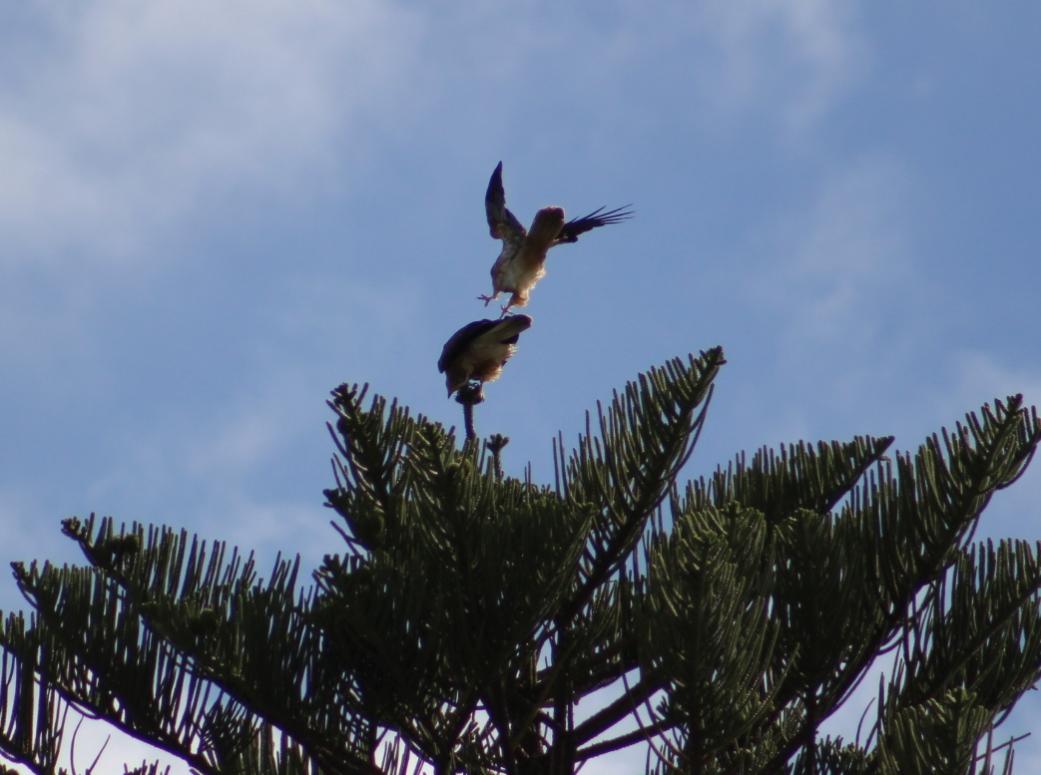
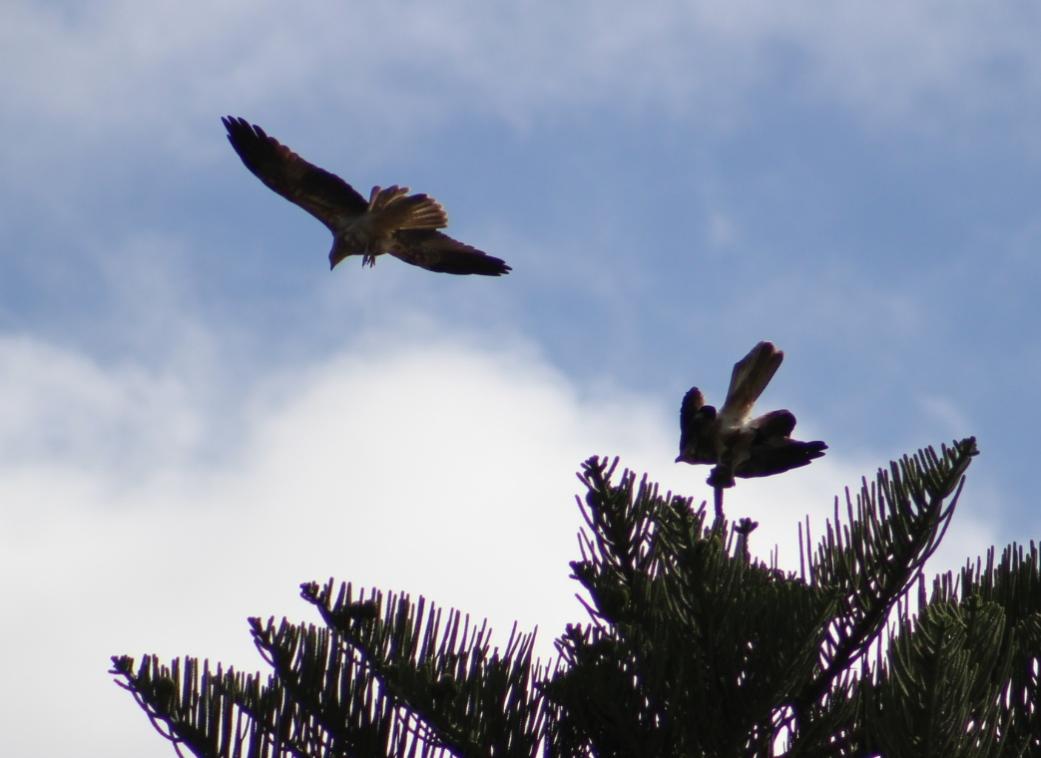
Whistling kite (Haliastur sphenurus) pair having a tiff over food in Norfolk pines at Palm Beach ferry wharf, Pittwater Park, Friday March 31st, 2017. A J Guesdon pictures.
Let's go fly a kite
Up to the highest height!
Let's go fly a kite and send it soaring
Up through the atmosphere
Up where the air is clear
Oh, let's go fly a kite!*
One of the best ways to have fun, and be creative, is to make a kite and then test out what you have made. Kite making and flying is an ancient art and fun exercise with some of the earliest kites said to have been made in China in the 5th century B.C.
Kites have been employed for more than just fun though - Australian inventor Lawrence Hargrave developing a box kite led to the development of what we call today the aeroplane and all that has developed aviation. His kites were also employed for gathering weather information where the box kites were carriers of data collection instruments such as the Marvin Meteorograph which measured against time, air pressure, temperature and humidity.
We found some news from those days, including a record of that first full flight in Australia by Mr. Taylor that occurred here, at Narrabeen, in 1909, one of the people who knew Mr. Hargrave, as it's pretty interesting to hear abut these things from the people who did them, while running what they published when they did gives you a sense of being able to be in that time, or at least recognise these things really did happen, here, and then. Those items run below.
First how to make some kites - and since that too is something that has been around for so long; some classic designs people have made before today from those yesterdays. As these are also done in measurements of inches in some cases, this table will help you change those measurements to suit today's rulers and tape measures:
Inches to centimetres conversion table
Inches (") Centimetres (cm)
0.01 ″ 0.0254000 cm
1/64 ″ 0.0396875 cm
1/32 ″ 0.0793750 cm
1/16 ″ 0.15875 cm
0.1 ″ 0.2540 cm
1/8 ″ 0.3175 cm
1/4 ″ 0.635 cm
1/2 ″ 1.27 cm
1 ″ 2.54 cm
2 ″ 5.08 cm
3 ″ 7.62 cm
4 ″ 10.16 cm
5 ″ 12.70 cm
6 ″ 15.24 cm
7 ″ 17.78 cm
8 ″ 20.32 cm
9 ″ 22.86 cm
10 ″ 25.40 cm
How to Make a Kite.
Having decided upon the size, the skeleton is to be prepared in the following manner (see Fig 1). A straight, strong, but light, lath should be obtained, of the required length, to form the backbone of the kite; it should be shaped to a point at the 'top. A small piece should be notched out of the lath a short way from the top on each side, and also on each side a little way from the bottom. The former notches are to hold the string which fastens on the bow, the hitter are to catch the strings over which the paper or calico is to be pasted. A notch is also to be cut at the point marked H in the figure.
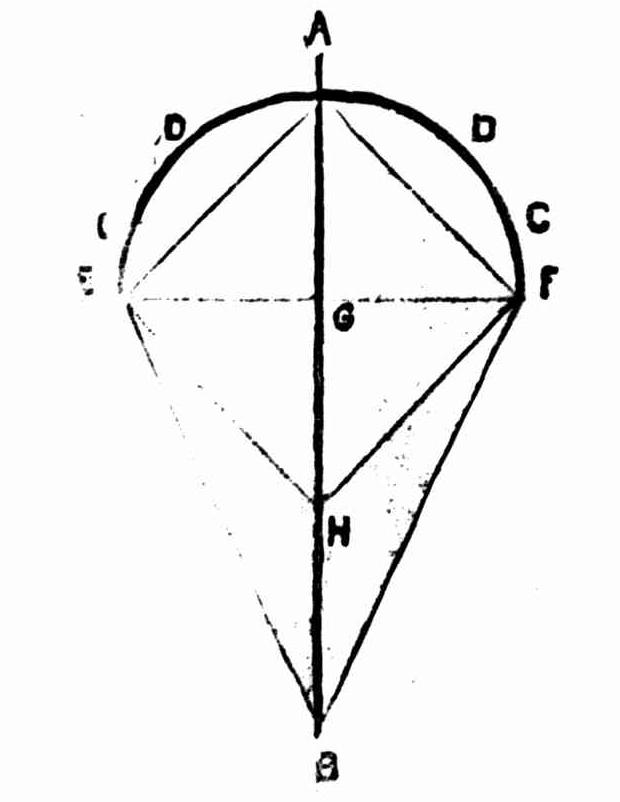
The backbone is also known and may be described as the 'standard,' ' straighter,' or' upright,' and is marked in the diagram A b. The ' bow ' or ' bender,' marked c B, should be of a piece of pliant wood, such as may be obtained from the ash or hazel, should a piece of cane not be readily procurable. A piece of a wooden hoop, thinned down to the thickness of a common cane, will be found useful, out of which to form the bow. Whatever it be, it is essential that it be of equal thickness and weight throughout its whole extent, and that its length be about the same as the backbone.
The exact centre of the bow should be next ascertained, and fastened with thin string to that point of the backbone where the first two notches were cut. A small notch is then to be cut at each end of the bow, and the bow bent down to the points marked B and p. In the diagram the thick lines represent the bow and the backbone of the kite, which are made of wood, as above described ; the thin lines represent string, and should be secured to the wooden frame as follows :— Secure the end of the string at the point e, pass it on then in succession to the points b, f, e, A, f, h, and e, fastening the string at each point, and upon fastening the string from F to E twist it once round the backbone at the point G. The skeleton is then complete; but if the balance is not quite true, shavings from the heavier -side should be sufficient to remedy the defect. The point next to be decided is the covering. All things considered, paper is best for an all-round kite ; paper kites truly are very easily damaged, but then the damage is as easily repaired, and paper is inexpensive and always to hand, old newspapers serving the purpose as well as any other kind of paper. For the largest kites, calico, silk, or thin gutta-percha cloth may be preferable, but even for these very stout paper will be found to answer every purpose. It is to be remembered that small kites require to be made of thinner and lighter material than larger ones. Having agreed to use paper as the covering, it should be cut the size of the kite, leaving a margin just sufficient to overlap the bow and the strings, so as to curl round; the edges of the paper should then be fastened to the frame of the skeleton by means of gum or paste, and left to dry.
The covering is to be secured to the backbone of the kite by pasting some slips of paper across the back of the kite. If the kite is large it is also well to secure the covering to the cross strings in the same manner. Should it be found that one sheet of paper is of insufficient size, two or more sheets may be pasted together, the edges of which should overlap about an inch. Calico, or materials of that nature, may be sewn on the strings and bow instead of being pasted on, and should in that way also be secured at the back to the cross strings and the backbone. Before securing the. covering to the backbone two holes should be pierced therein, the one at the fifth of the whole length from the top, the other at a trifle less than the same distance from the bottom. Through these holes a string is to be passed and fastened at the back of the kite; this string is known as the 'belly-band,' and to it is fastened the string by which the kite is flown. The kite proper is now complete; but as the kite cannot fly without a tail, the construction of that appendage is next to be proceeded with. Ordinarily, the tail is a long string with pieces of folded paper fastened on to it at regular intervals. Its length depends on the size of the kite and the weight of the string and paper out of which the tail is made, together with, a number of other considerations, all of which experience will soon point out. It should, however, never be less than twelve times the length of the kite, and the longer it is the better, so long- as the kite is big enough to carry it. The tail papers should be tied on by noose knots, and at intervals or from three to four inches. A paper tassel tied to the end of the tail forms a graceful finish. The tail is then complete and ready to be fastened to the bottom of the kite; for convenience of carrying, it is better to keep it rolled up, and to fasten it on only when the kite is in its field from which it is to be flown.
The use of the tail is to steady the kite and to keep the kite's head to the wind. If the kite seems to rise with difficulty the tail has probably been made too heavy; should the kite dip and plunge, or show a tendency to topple over, the tail is probably too light, and may be weighted with any convenient object, a stone or piece of turf being generally found handy and serviceable. Wings or tassels attached to the end of the bow add to the graceful appearance of the kite, but will be usually found to diminish its flying powers. Experience will in this matter, as indeed in all others, soon teach when tassels may be judiciously affixed and when removed, the state of the wind having very much to do with, all these questions of additions to and ornamentations of kites. How to Make a Kite. (1886, April 24). The Sydney Mail and New South Wales Advertiser (NSW : 1871 - 1912), p. 878. Retrieved from http://nla.gov.au/nla.news-article162815769
HOW TO MAKE A KITE
Material, needed: A lath 38 inches long, a, piece of string, a piece of thin cane 34 inches long, a sheet of strong paper or 1 yard of balloon fabric. Several newspapers.
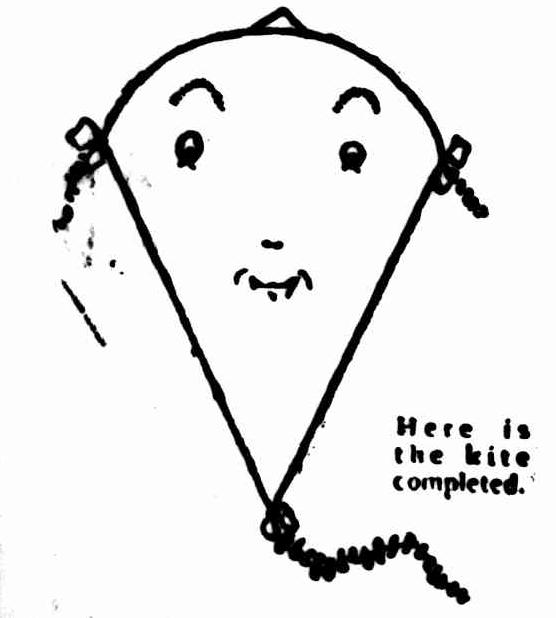
First make two notches in the lath, or spine; each about 1 ½ inches from the ends. Make a similar notch in the centre of the cane and attach it firmly to the notch at one end of the spine. Bow the cane by tying a piece of string between the ends; the distance between should be about 28 inches. Without cutting the string, carry it down as far us the notch as thee lower end of the spine; tie it tightly here, and carry it up to the other end of the bow.
Now you have the outline of the kite. Lay it over the material and cut out in the balloon fabric, allowing 13 inches all round for turnings. Tuck in the ends over the framework and sew tightly with strong thread, using over and over stitches. The tail can be made from a long piece of string with twisted 4-inch lengths of paper, tied at intervals about 4 inches apart. In the spine of the kite make two holes for the string; the holes should be about 18 inches apart, the top hole coming about 7 inches from the top of the kite. HOW TO MAKE A KITE (1928, February 22). Northern Star (Lismore, NSW : 1876 - 1954), p. 12. Retrieved from http://nla.gov.au/nla.news-article93662971
Things to Make and Do: KITES ARE IN— So Make This WHISTLING BOY KITE
AMONG the people of the Far East (who are the world's kite experts) whistling kites are common. This week we give directions for making a whistling kite of a rather unusual design. The sketches show clearly how the kite is made up, in the shape of a boy, the whistle in this case being placed in the boy's mouth. In the East reed whistles are used. You will find it easier to use one of the round, flat whistles that are sold very cheaply, but if you are one of those boys or girls who prefer to do everything your own way, you can easily make a whistle as shown. The framework is made of straight, light sticks. The spine is 2 ft. 5 in. long. For the boy's head, make a circle of cane 8 Inches diameter, and bind it to the top of the spine with thread, making sure that the spine divides it exactly. Cut a stick 3 ft. 6 in. long for the cross stick that makes the arms; bind it at its exact centre to the spine, at a point 3 inches below the bottom of the head. Two sticks 3 ft. 9 in long form the legs, bound to the spine and the arms in the diagonal positions- shown. The tops at these sticks are bound at points 7 Inches on either side of the spine.
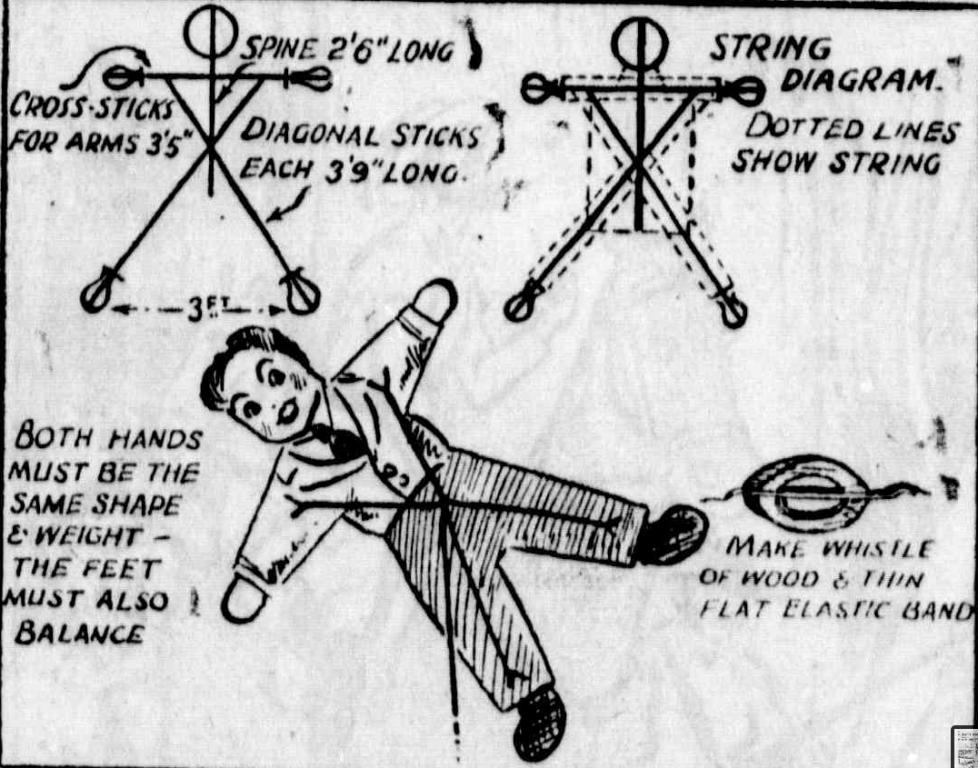
The distance between the lower ends of the legs should be 3 feet. The hands and feet are loops of cane, each 3 in. across, and bound at the ends of the respective sticks. The hands and also the feet must match exactly, or the kite will not balance properly. Four more short sticks, 3 inches long, are bound to the frame to form the ends of the boy's sleeves and the bottoms of his trousers. Bind them at right angles to the arms and legs, just at the tops of the hands and feet. One of the diagrams shows how to string the kite. Be sure that the strings are evenly placed on either side of the spine. Where the strings cross the spine, arms or legs, give them a turn around these sticks. Keep the lines parallel and at equal distances on either side of the limbs. Japan tissue, the material used for covering model aeroplanes, makes a good cover for this kite, but any other strong, light paper can be used. First paste sheets of tissue or paper together until you have a piece a little larger that the frame.
Then cut around the frame, leaving a margin of about an Inch all round for the overlap, and paste the flaps, over the strings. In order to make the paper fit smoothly, cut silts in the overlap at every point where the angle changes. Make slits about an inch apart around the circular parts (heads, hands and feet), Keep the paper tight as you paste it down. A coating of aeroplane "dope," applied to the paper after the paste has dried, will toughen and waterproof it. Now you are ready to paint on the design, which should be done in colors. The hair may be made with a few wisps of colored wool pasted to the head. The whistle you use must be very light. If you make it yourself, use two small blocks of balsa. It should not be more than l1 ¼ in. long, and almost round. Hollow out the blocks on one side. Stretch a piece of thin tubber tightly across- the opening, then bind the blocks together with adhesive tape. The whistle is attached in the exact centre of the face with thin strips of adhesive tape, a ½ inch hole being made through the painted mouth to let the air through. Two strings tied across the body from the shoulders to the legs, and tied where they cross, as shown in the sketch of the finished kite, form the bridle to which the flying string is tied. The kite will need a tail. This is attached to a loop of string tied between the two legs. Things to Make and Do (1937, October 15). The Age (Melbourne, Vic. : 1854 - 1954), p. 4 (JUNIOR SECTION). Retrieved from http://nla.gov.au/nla.news-article206729756
SOMETHING TO MAKE: THE ARGUS JUNIOR - A BOX KITE
TO MAKE THIS KITE, you will need four sticks of soft, white wood measuring 2ft by 4in by 1/4 in square, four pieces 16 1/2 in. long by 1/4 in. square, some thin brown paper 4ft 2in long, glue, 10 fine long tacks or brads 3/4 in long, and a ball of string with which to fly the kite.
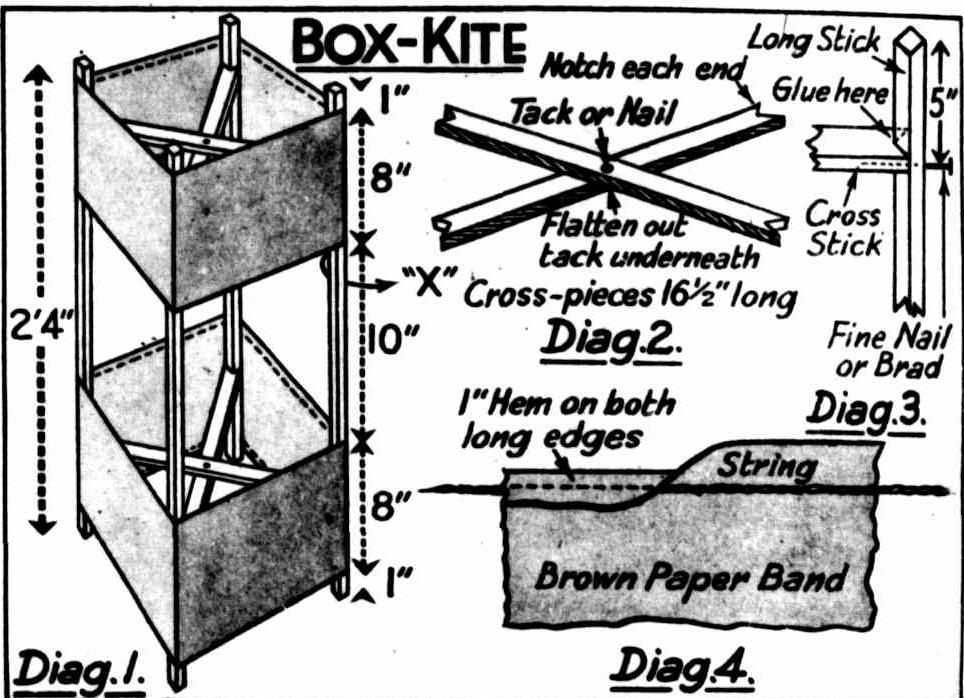
Diagram 1 shows the finished model, and you will notice that no tail is needed on this kind of kite.
Diagram 2 shows how to tack together two of the shorter pieces after they have been notched each end. Flatten out the end of the tack underneath. Make two crosses in this way.
Next, fix these two crosses 5in from the top and bottom ends of the long sticks. Glue the notched end on to the big stick as shown in Diagram 3: If you hammer a fine tack or nail in carefully, it will help to hold it firm.
When it is assembled like this the frame is ready for the paper covering.
Cut out two 10in strips, each being 4ft 2in long. Bend over a 1 in. hem down each long side, and then place a piece of fine strong string under the hem and then glue it down. See Diagram 4.
Put glue on the outside of the long sticks, starting 1 in. from each end and continuing along the stick for 8in. Fold the paper around the sticks, over this glue, and glue down the overlap (about 2in).
When it has dried off, your kite is ready to fly, and all you have to do is to tie on one end of your ball of string at the point marked "X" in Diagram 1. SOMETHING TO MAKE: THE ARGUS JUNIOR (1947, October 7). The Argus (Melbourne, Vic. : 1848 - 1957), p. 6 (The Argus Super Comic). Retrieved from http://nla.gov.au/nla.news-article22512212
"Let's go fly a kite" from the movie 'Mary Poppins'
More about Kites - from Pages past and present
THE BOX KITE.
Kite flying has its fascinations for more people than the Chinese. In fact, it has been turned from an amusement into a very useful means of taking photographs and or assisting in scientific matters belonging to the observatory. The box kite, which has superseded the tail kite, is the invention of an Australian, Mr. Lawrence Hargrave, of Sydney. The kite consists of two light wooden boxes, without tops or bottoms, fastened some little distance one above the other. The wind exercises its lifting power chiefly upon the front and rear sides of the upper box, the lower box. which inclines to the rear and so receives less pressure, preserving the balance, while the ends of tile boxes, being in line with the wind, keep the kite steady. Kite flying is much indulged in at the observatories of France, Germany, and the United States, but the best equipped station is 'found in the last-named country at Blue Hill, Boston. At no other, place in the world has kite-flying been raised to such a science. It is here where all the records have been made; and the methods employed for exploring the upper air with the little captive airships are decidedly unique and interesting. When it is stated that the kites used vary from six to twelve feet in height, weigh from ten to fourteen pounds and contain from fifty to one hundred square feet of lifting surface each, it is not difficult to see that it would be impossible for human agency to keep such huge soarers under control at any height. Indeed at nearly all the large weather observatories kites are controlled from a machine, the apparatus at Blue Hill being the most elaborate. This latter is an ingenious piece of mechanism, designed on the same principle as the deep-sea sounding apparatus, only that the wire is made to pull upwards instead of downwards. The pull of the kites during ascent is sufficient to unreel the wire, which, by means of a pully, is delivered; to -them as required, an attached wheel meanwhile recording the pull on the line and_ the length paid out. A fine' steel music-wire is employed, weighing only fifteen pounds to the mile, and capable- of I withstanding a . pull of three hundred i rounds. The kites are drawn in by a two I horse-power steam engine at the rate of j from three to six miles an hour. When they go up the kites carry an ingenious instrument called a meteorograph. This is virtually a combination of a barometer, a I thermometer, and a hygrometer, all of ( which record their readings automatically -on one cylinder turned by clockwork, each revolution occupying the space of twelve hours. The instrument is made of aluminium and weighs three pounds. To attain a greater height, more than one kite is flown on the same line. Indeed, five and six kites are generally attached to the same wire, while there is a record of twelve kites being attached to the same rope. Wonderful strides have been made during the last few years in the height to which it is possible to fly kites. In 1899 a kite at Blue Hill ascended to the then record altitude of 12,441 feet. More recently the distance was increased to 14,009 feet, thus beating the previous record by nearly 2000 feet. THE BOX KITE. (1907, December 27).Lithgow Mercury (NSW : 1898 - 1954), p. 7. Retrieved from http://nla.gov.au/nla.news-article219137212
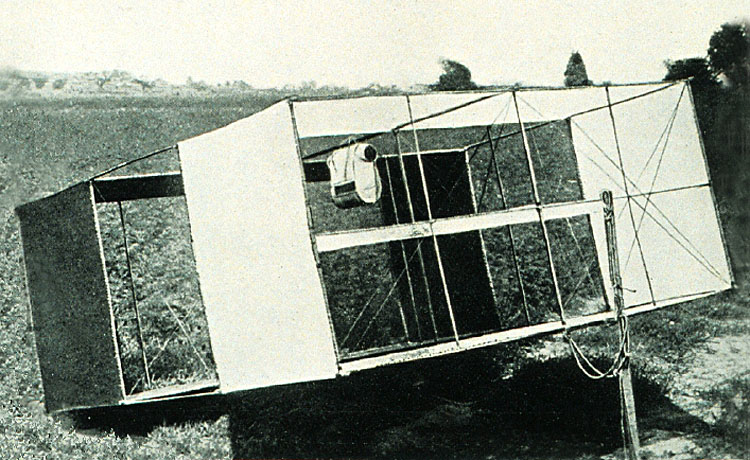
SCIENTIFIC KITE FLYING.
CENTURY MAGAZINE.
Most persons when asked for their mental picture of the wind, describe it as a horizontal stratum of air practically uniform in velocity. In reality neither of these characteristics is a part of the description of the wind. Investigations into the internal movements of the air currents, made by Professor S. 1'. Langley in America and by others abroad, have shown conclusively that the wind is made up of innumerable commingling and conflicting currents, much like the multitude of scarcely perceptible wavelets which unite to make up a huge billow. These component currents move in various directions, vertically as well as horizontally, and with velocities quite their own. The constant variation in velocities may be detected by anyone who will watch a cup-anemometer whirling in a gale of wind. A little patience will soon detect the cups at a full stop for an appreciable period, while the gale whistles by. Meteorological instruments have detected distinct upward and downward movements in ordinary winds, and some of those who are investigating bird flight and the vast subject of aeronautics are convinced that the soaring power of a bird is due to its instinctive recognition of these upward currents, and to its ability instantly to make use of them in order to secure or retain altitude. Much in the same way as billows move in one general direction, a given wind usually follows a uniform course; cut if it meets a terrestrial obstruction, it is at once retarded at some points, and a mingling of forces results. A hill obstructs the wind much as a dam retards water. The current in the stream is more rapid on the surface than at the point of contact with the dam. In the same way, the anemometer on a mountain top may indicate a certain velocity, while the clouds above, moving in the same wind, will Ire observed to be moving much faster. In order that weather' predictions may be made with greater certainty, it is necessary that the atmospheric conditions above may be frequently investigated, perhaps several times a day, and the results compared. If this be done in concert at several points far apart, the results will of course be of greater value, and the coming changes over a larger territory can be far more accurately predicted.
So it comes about that the toy which has amused the Chinese and the Coreans through countless dynasties (for the origin is in tradition), and which the Japanese adopted just as they did Chinese art, has come to be a scientific instrument of unique value. Kite flying is generally associated with a fair wind in an open field in the summer; but as meteorologists use kites, a snowstorm, a freezing temperature, or a gale of 30 or 40 miles an hour, does not deter the work in the _ least. It has again happened that amateurs have pointed the way for scientists. In the face of scientific deductions from known facts, it has been demonstrated that light kites can be constructed that will resist the pressure of great wind velocities and at the same time lift considerable weights. In this practical demonstration amateurs have been foremost. The best knowledge on the subject a few years ago, when kites were first taken up seriously, was so deficient as to be virtually useless. Many of the materials used in kite construction had not been tested at all; and others had never been tried under conditions similar to those in which the strain was to occur. No one knew the breaking-point of different kinds of string, or what kind was, on the whole, best when compared weight for weight or by diameters. The manufacturers had never had occasion to make such tests.
The safety of the whole apparatus in use depends upon the original strength of the string or wire used, and upon the knots in making connections. The literature of kites gave no information as to the best methods of tying a string on itself, or on a foreign object like a kite stick. It is clear that tying two ends of a broken string cannot restore it to its former strength, since the parts in the knot cut on each other. It was essential to find the most efficient knot, and until this was done no high altitudes with kites were possible, and tandem flying was Hazardous to the apparatus. The breaking point of the woods commonly used — straight grained spruce or white pine— and the force of the wind per square foot on a flat surface at right angles to the wind, were of course well known; but these and all other facts accessible two years ago pointed to the conclusion that kites would probably never be sent up. more than 3000 to 4000 feet, and that no kite could be made strong enough in proportion to its weight to fly in winds varying from 10 to 40 miles an hour. The absence of data much needed in order to proceed on scientific lines in devising kite forms was due to the fact that the kite had always been considered a toy, and but for the development of tailless kites it would have doubtless still be so regarded. The moment the weight and resistance of the tail may be safely discarded, the kite is able to lift so much more, and self-recording instruments may be attached; but any kite that can lift only itself is obviously useless in meteorology.
The two forms in use, the Malay and the Hargrave, or cellular, are widely different. Both are tailless, and while the latter is by far the more efficient, the former, on account of its extreme lightness per unit of area, will doubtless be used for a long time to come in tandem flights in conjunction with the cellular. It is found as frequently in the kite literature of Japan as any other type.
The only change from the Japanese form is in shortening the distance from the top to the cross stick. Except for this improvement, the kite is identical with the one which the Japanese, Chinese and Malays have always flown. This kite owes its buoyancy to the fact that the sections below the cross stick are so proportioned as to balance under wind pressure those above, provided the bridle is tied on correctly; while the planes on each side of the upright stick, containing the same total surface, must balance each other, unless the cross stick bends unevenly, in which case the kite is driven over to the weak side, and may refuse to fly. It is found that unless the lower planes are made somewhat loosely, so as to bag in the wind, the kite will not remain in equilibrium without a tail. On the other hand, there is a serious loss of buoyancy and "lift" if the cover is too loose. Formerly these kites were covered with strong paper, but light cloth, like nainsook, is now-most frequently used, and with great advantage in durability. The loop or bridle to which the flying string is tied is generally fastened to the kite at two points only, and this permits the planes on each side of the upright stick to move laterally with freedom; but the writer has obtained much better results with the same kite by fastening additional hangers at each end of the bow. The point on the bridle at which the flying string is tied determines the kite's angle of incidence. If the angle is too great— that is, it the nomt is too low on the bridle— the kite will not rise; if too small, it wall dive for if Inclined too nearly parallel with the ground the wind docs not strike the surface with sufficient force to establish equilibrium.
SCIENTIFIC KITE FLYING. (1897, June 28). The Age (Melbourne, Vic. : 1854 - 1954), p. 6. Retrieved from http://nla.gov.au/nla.news-article190648337
This article has been written by George Augustine Taylor who owned this journal, the Construction and Local Government Journal, begun November 1913. Mr. Taylor is the gentleman who experimented with a motorless aeroplane (glider) and, in November 1909, constructed one of full size. He also contacted the retired inventor Lawrence Hargrave at this time. On 5 December, at Narrabeen, Mr. Taylor flew in the glider he had designed and became the first person in Australia to fly in a heavier-than-air craft. His wife Florence Taylor flew in her husband's glider on the same day, as did Edward Hallstrom and Mr. and Mrs. Len Shultz. Although gliding had been done in America and Europe many years before this, the principle and design of Taylor's machine appear to have anticipated the types being used in Europe more than 10 years later.
You will read in this article that Mr. Taylor states the flights took place in October 1909 while others state, and report it was December 5th, 1909. There are also many more photographs included in this article than placed here - the rest may be seen by following the link at the base of his report.
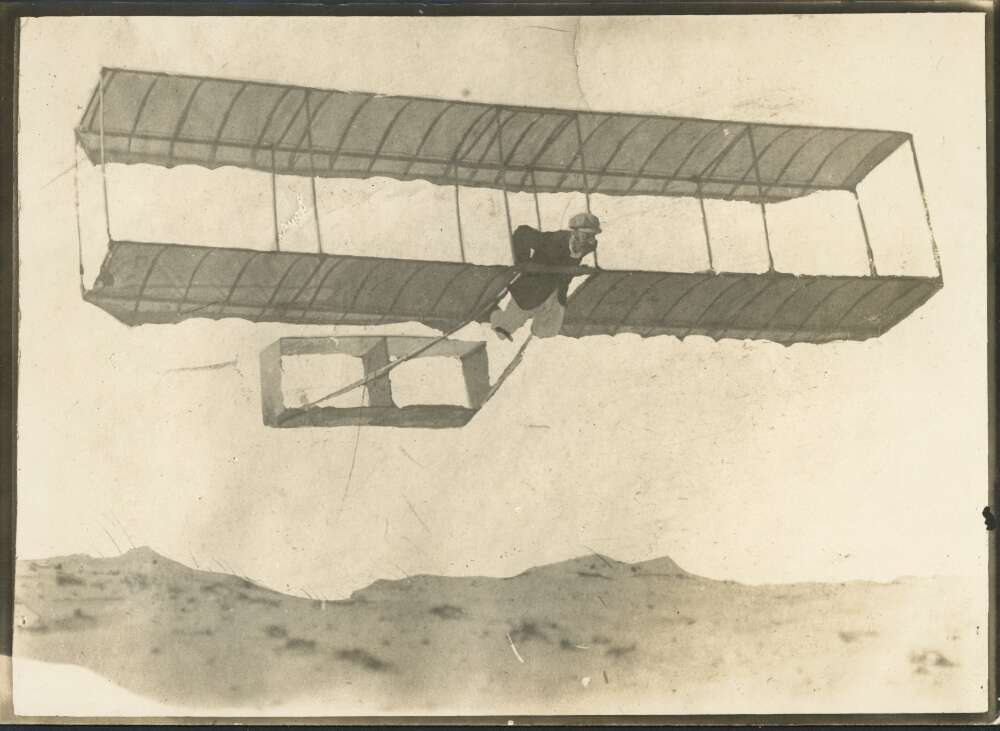
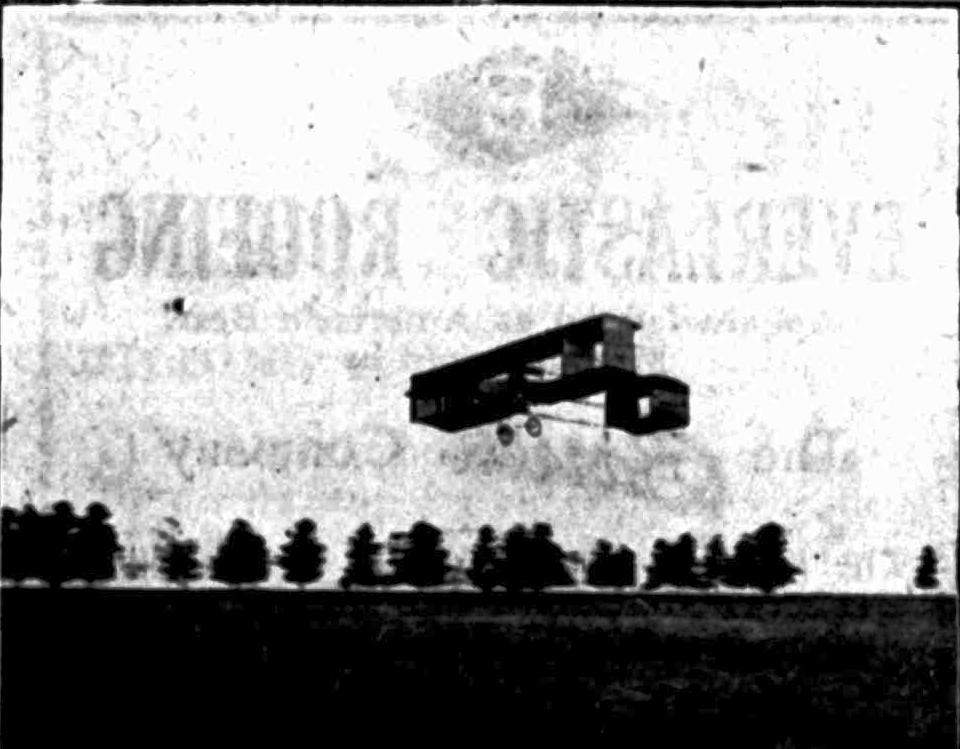
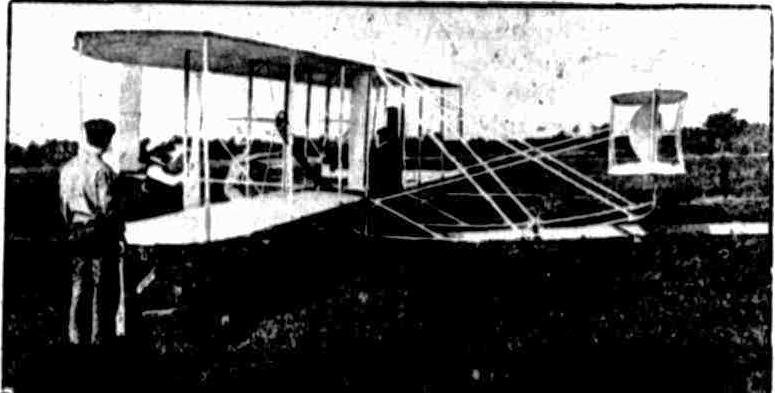

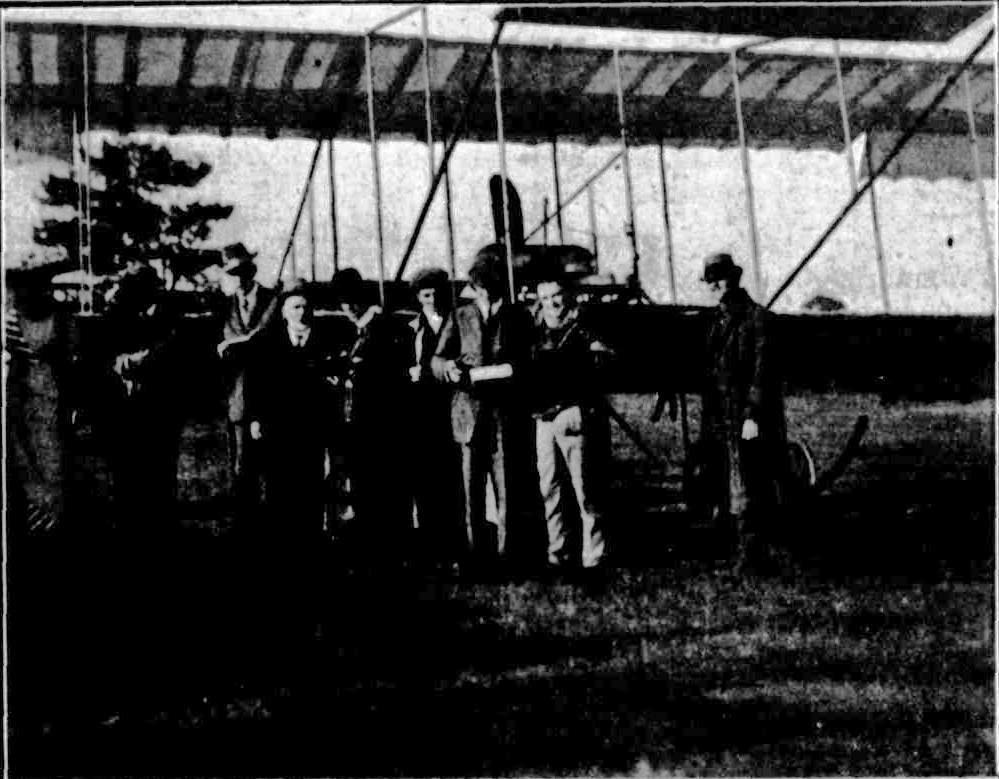
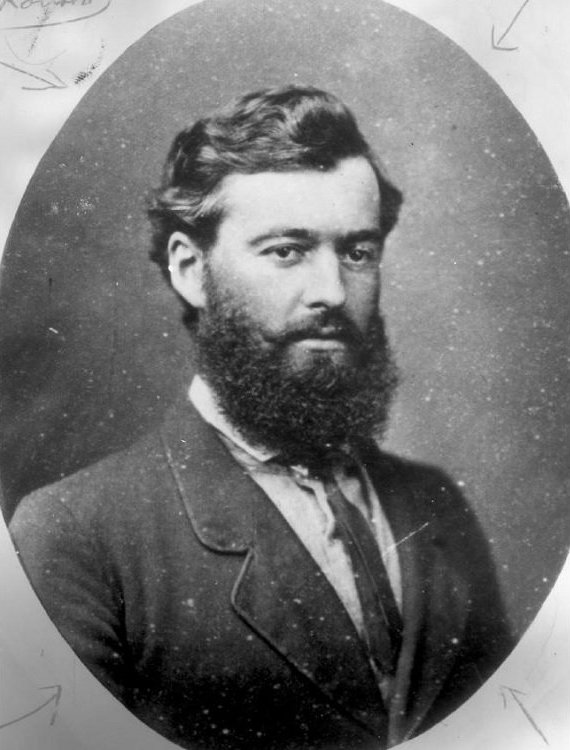
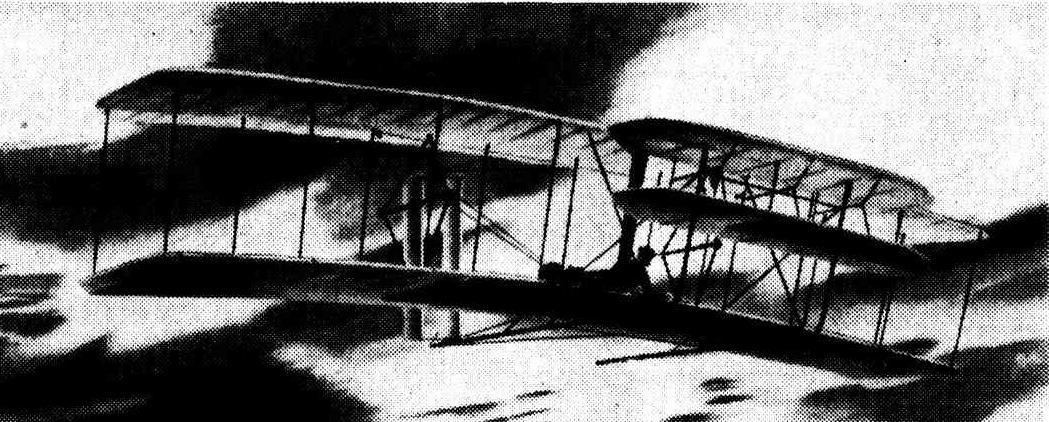
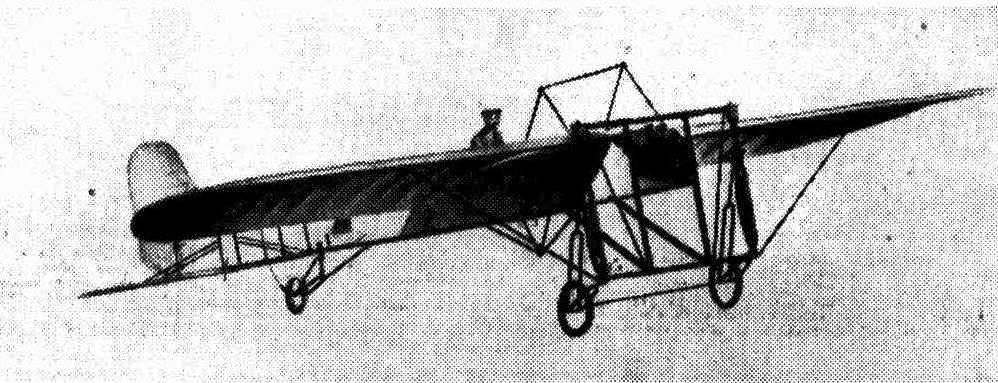
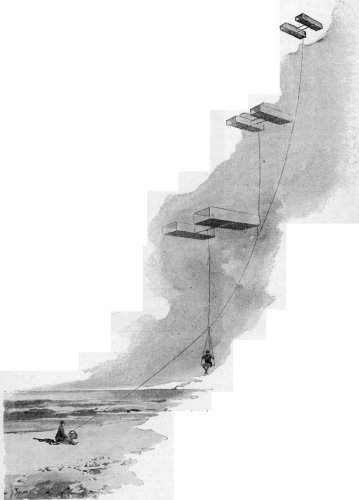
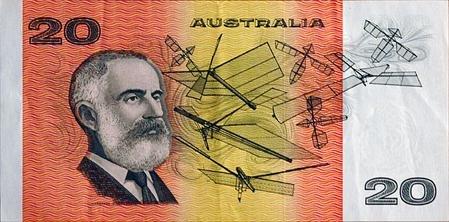

Aviation and Common Sense
WHERE FLYING CAN BE USEFUL . The Grave Danger of the Present Boom
THE GOVERNOR-GENERAL 'HAS A FLY' 1918
I have been bombarded by readers with requests to say something regarding Australia's Aviation possibilities and the effect upon Town Planning and Building now that a plucky Australian, (Sir) Ross Smith, has proved it possible to fly from England to Australia. I have hesitated for two reasons. The first reason was because I considered my Aerial propaganda work was finished once the necessity for the aeroplane in Defence was clearly proved ; and with the help of many whole-souled helpers, the Australian Government was forced to adopt the aeroplane just in time to give Australian lads the spirit for aerial fighting that brought them such glory in that Great War that many of us could foresee. The second reason why I have hesitated, was because Australian Aviation was becoming infested with company-promoters; who, though perhaps sincere in their intentions, could in some instances be clearly seen to be led astray by the sensational side of Aviation, and who were certainly leading many investors into money-wasting ventures that would bring discredit on the science of Aviation, and so be used as an excuse by Parliamentary opportunists to block any Government financial support for the building up of the efficient Aerial Military Defence that. Australia needs. There was a particular Aviation Company that had much that was peculiar about it. It issued a prospectus with a breezy nonchalance 'that the possibilities of the flying machine are not in these days matters to be speculated on.' After pages of matter dealing with Stephenson, Jules Verne, Santos Dumos it summed up the respective stages of the route from Australia to England in this fashion : — . 'First Stage. — Sydney to Cape York, 1600 miles; 'no peculiarities.' Second Stage. — Cape York to Rangoon via New Guinea, Celebes, Borneo, Penang, 2000 miles' — whilst the third stage, 'Rangoon to Calcutta,' had this rather humorous notice: — 'No peculiarities — country good for flying — have to cross Irrawaddy River, which is about 8 miles wide.'
In a preceding paragraph on the prospectus, the route suggested was via 'the Nor'-west coast of Australia' (note the breezy abbreviation) and the jumping off point was taken as Derby or Wyndham, the first stretch thereafter being to Timor, it being said that the greatest water jump is 100 miles, yet the distance from either of these places to Timor is quite 400 miles!
The most remarkable part of the document, however, was the appeal to the patriotism of the reader, for this annihilator of distances blandly said: 'it' (the mail) may be carried by way of the all red ‘route over Empire-held territory' for the'' whole distance' though his suggestions included flying over Italy and France.
The part of the document that was really serious, was that relating to finance. After declaring that, he had been too intimately associated with Big Money in all parts of the world — in twenty distinct countries— to think 'for one moment' that capital is the simple fish that will rise to a gilded bait,' the' promoter of the Company; Lloyd, declared that he submits 'a gilt-edged proposition.' The officials of his Company, including himself, set off to survey the route. I pointed out at the time in one of my journals that I was particularly sorry to sec the concern starting out on such an expedition, because there seemed little possibility of any financial profits accruing to the shareholders, hence the failure of such a company would throw such ridicule on Australian Aviation, that the public would probably object to foot the big bill that would later have to be met for Australia's Aerial Defence, as there is no doubt whatever that Australia's best defence will be from the air, and we were hopeful that most of Australia's Aerial Forces would, on the return of its members to Australia, be absorbed into a great flying corps for service at home.
However, Lloyd's affair went off, its members quarrelled and its only 'aerial expert' came, back disgusted; and this was the sort of concern that induced a prominent military officer to lend his financial assistance in the floating of the Company, hence any discredit on the science must, therefore, hit at the Military aspect of it.
Another private concern bought aeroplanes at a cut rate from the Commonwealth Government, and though they were only 'trial' machines, they were announced to give 'record flights from Melbourne to Sydney,' and a letter from the Lord Mayor of Melbourne, was given to one of the aviators to be handed to the Lord Mayor of Sydney. The first of the aeroplanes to reach Sydney took, over a week to do the journey, so that the Sydney 'Daily Telegraph' mentioned that the letter from Melbourne was received in the Sydney Municipal Council with 'ironical laughter,' in fact, the press, generally, sneered at Aviation in Australia.
The writer foresaw this state of affairs when he first advocated that Aviation ' should be controlled by the Federal Government and wrote that: 'With the 'ironical laughter’ and 'sneering comment,' ' Aviation will get so much ridicule that when the public is asked to vote the very great sums necessary for our best Aerial Defence, political adventurers will attempt to win the public support by 'blocking same,' in fact, the Melbourne 'Age' was then objecting to the amount requested by Federal Parliament for Aerial Defence.
To-day, the achievements of Sir Ross Smith and his comrades, excellent as it is, seems likely to exaggerate the outlook for commercial aviation, particularly. as some military officers are' allowing the late war conditions to over-color their Judgment regarding the value of the aeroplane outside the sphere in which they had recently been directly and most worthily interested, and they, seem to forget the business is a cold matter of fact proposition with little if any sentiment about it.

SOARING AT NARRABEEN, N.S.W., 1909 - This version: 'George Taylor flying at Narrabeen', N.S.W., 1909. Courtesy National Library of Australia. Pictures nla.pic-an24152661

THE VOISIN AEROPLANE IN VICTORIA Houdini flying at Digger's Rest, 1910.
Hence, it may perhaps be considered opportune to have a chat on the subject.
A Look Back
It is interesting to look back and note, that so far back as 75 years ago, Aerial Company promoters were just as busy in Australia as they seem to be to-day.
An Early Flying-Company
In the 'Sydney Gazette' of December 21, 1844, there is mention, of 'a prospectus being before the public for forming a company for navigating .the air on a machine, called an Aerodipher and which machine is capable of being, made to carry ten or 'twelve persons, or more, and- equivalent weight of luggage, propelled by steam power, at an average of 100 miles per hour, which can .be' increased if necessary. The nominal capital of the company to be 500,000 in 5000 shares of 100 each, '2500 shares to be approximated to the public, and the remaining 2500 shares , to be the property of the inventor.'
The Start
Nothing of any consequence seemed to have happened till 1884 when a marine engineer, named Lawrence Hargrave made a small model that flew 384 feet and so opened the way for the conquest of the air. It was the first inanimate thing in the history of the world to fly with its own power. A native of the newest of continents had solved the problem that the earth had puzzled over, from most ancient times— yet Australia did not bother, in fact, 'Hargrave' even by Australia's greatest scientific men was looked upon as, a 'bit silly.' He wrote thirty years ago that 'the people of Sydney who can speak of my work without a smile are very rare.'
Professional Ridicule
Public ridicule he could well understand and attribute to ignorance, but it was the callousness of professional men that cut into his heart. His contributions to the Royal Society, though solving the long probed mystery of human flight, were never even discussed. But he fought on. His models were of exquisite beauty of workmanship and most delicately fashioned. For one of his boilers he required 190 feet of copper tubing. The pipe on sale in Australia was too thick and too heavy for the extreme lightness he desired for his flying model. He could not send abroad for the required tubing, so he purchased 190 feet of copper wire, shaved it to the thinness he desired, and bored a hole through its length, inventing a special lathe to do it!
National Ridicule
It was this dogged perseverance that carried him on in spite of ridicule, and in his beloved models were preserved the patient and laborious work of thirty years. In 1909 I begged of Hargrave to present these models to Australia. For a while he hesitated. He no doubt remembered with a pang the ridicule of the previous quarter century, but I pleaded that the Wright Brothers in America were beginning to fly as the result of the principles first demonstrated by his models: hence the possession of the latter would, in the coming flying age, make their museum a world's centre of attraction. After much persuasion I convinced him, and he permitted me to offer his beloved models to the Premier of New South Wales free of all charges. I did so, and was cooly informed 'they were not required'.
On March 12, 1909 I wrote in the press : 'Fortunate the city that will possess these. One can understand the future pilgrimage of world tourists to view the wonder works' that solved the problem of human flight. They may be eagerly snapped up by Germany.' But Australia didn't bother!
Germany Scores
Hargrave afterwards told me that Germany was after his models, and so he let her have them for the Munich Museum and as Germans are such fine copyists, it is galling to think that in the losses of our fighting men during .the, period of German air supremacy in the early days of the war, we may have been punished for our neglect in the past.
The Fight for Australia
However, when in March 1909 New South Wales Premier Wade rejected the offer of Hargrave's models made by the writer, the latter called a public meeting at the Hotel Australia,. Sydney, to form an Aerial League of Australia, with the following objects :—
(1) To watch the latest achievements in Aerial Engineering.
(2) To secure best recognition for Australian efforts in that direction.
(3.) To awaken public attention to the grave danger in' allowing foreign nations to excel in Aerial Navigation.
(4.) To join forces with the Aerial League of the British Empire in advocating that the Empire should secure the same supremacy in Aerial Navigation as it has enjoyed in the command of the Sea.
At this meeting Hargrave was placed in the chair, the writer acting as Hon. Secretary well assisted by C. Rosenthal (now Sir Charles Rosenthal) as Hon. Treasurer. Other good friends on the Executive being: — Norman Selfe (since passed), J.M. Smail, C. L. Garland. Commander (now Captain) Brownlow, Col. M. L. Yernon (since passed), Col. Holmes (since passed), Major (now Colonel) Wilson, J. \V. Turner (since passed), T. R. Roydhouse, Captain Niesigh and I. M. Merivale and Captain (now Major) Ernest Stowe.
The Aerial League did good work opening interesting exhibitions of models in Sydney and Melbourne, forming State Sections of the League in Melbourne, and Brisbane, and holding public meetings to draw the attention of the Federal Government to the value of the Aerial Defence for Australia.
The First Aeroplane
As nothing happened in that respect the writer determined to take a step to compel attention to the simplicity and value of Aviation, hence in October 1909, he built the first full-sized Australian Aeroplane. It was a biplane, with planes curved on the Hargrave principle, 33 feet long, and 44 feet, wide, covered with varnished calico, and, with it at Narrabeen near Sydney, in October, 1909, the writer was the first to fly in the air in Australia on a heavier-than-air concern.
National Competition
The press reports of the success called public attention to the affair and the Prime Minister of Australia by (Joseph Cook), asked the writer for a proposition. It was that a prize of £5000 be offered for the first Australian-made Aeroplane that could fly under conditions to be drawn up by the Military Authorities,' but when such conditions were published they caused considerable ridicule, as the' main Military condition was 'that the aeroplane should be able to hover,' the Authorities being so ignorant on the matter that they were unaware that a 'plane could only keep up when on the move. The Military Moves (So much ridicule was cast upon the Military Authorities by the Press, that the. former asked the writer to join the Intelligence Section of the Australian Military Forces, where he. was deputed to report on all Aerial matters, advocating and reporting on the establishment of Australia's first Military Aviation School (vide Commonwealth Military Journal), and so with the establishment of Military Aviation the fight' for its recognition was won.
Flyers Arrive
The first power-propelled aeroplane to be seen in Australia came along the year following the Narrabeen Aerial adventure, previously referred to. It was a Voisin machine, simply a number of Hargrave box-kites, with an engine, and was brought by Houdini, a theatrical conjurer. He flew with it first at Diggers' Rest in Victoria, afterwards bringing it to Sydney, where he flew it at Rose Hill Race Course, and finally, took it from Australia. Soon after, a Wright machine was brought to Australia by the Tate Bros., Theatrical Agents. It was a beautiful machine, but it did not fly, being heavily loaded with weights as it ran round the various show grounds in which it was exhibited. It was rather disappointing that the first type of machine to fly in the world should not fly in the land that gave the world the age-sought secret!
The end of the machine was as disappointing as its Australian' career, for its owners, in disgust, to save paying the heavy duty due upon it, took it, torn and disabled, outside Port Phillip Heads, and sank it in the sea. In the following year, 1911, England sent Australia a flier in the 'Bristol' biplane, and it did good work. It made the first aerial military flight in Australia, carrying Captain Neisigh, as observer, from Randwick to Liverpool in May 1911. Considerable Australian Aviation following, amongst which should be mentioned the splendid pioneering work done by W .E. Hart, who on one occasion flew in early morning from Parramatta to the Sydney Show Grounds. It was a remarkable feat at the time, as the ground was surrounded with high standing advertising boards, so that it seemed a case of 'flying into a bottle.' In this respect too much praise cannot be given to those great pioneering spirits, whose names have been mentioned, forming- the Aerial League not only in New South Wales, but also in Queensland, the Hon. Secretary of that State Section, Thomas McLeod (now Major) doing good work in the Great War.
The Aerial League of Australia all through did splendid work. Inaugurating aerial, races, making trials of machines; in fact, developing in Australians the sense of Aerial Defence, and preparing our lads for Aerial action, so that when the Great War crashed on the World, Australian lads were ready, and in the air did wonderful things, four of them actually returning from England to their beloved Australia by air instead of by sea !

THE WRIGHT AEROPLANE The first machine to fly, but not in Australia
What Should Be Done
So we come to the outlook today, and it should be shorn of all its sensational stunts, for the public is a quick-changing individual and speedily forgets. Aviation has points that for Defence purposes must be given keenest attention. The first step to be taken is for Aviation to be under Federal control. Already there has been too much State interference. The New South Wales Government established a Flying School at Richmond that was unnecessary in view of the good work being done by the Federal Aviation Authorities, and, though the State referred to lost much money in its'' aerial venture, it still persists in its interference; in. fact, it has now formed a Committee to advise the Government generally as to what steps might be taken to establish commercial aviation. The best advice that could be given, would be to hand the control over to the Federal Government.
New South Wales Premier Holman has one great fault. It is that he is always too apt to listen to any seemingly plausible tale told by self-seeking agitators ; and in this Aerial matter, his ever-open ear has been won by interested parties, with the result that his State may be let in for much money-wasting as well as loss of valuable time by trying to keep Aviation matters within State boundaries instead of letting the Federal Government go ahead with a National scheme of Aviation development.
Aerial Laws Required
Until the States hand over the control of the air to the Federal Government with the right to litigate on the subject there will be much delay in the framing of Laws of Aerial traffic. To-day, by the laws of the land, the aviator has no more right to pass over the property of another, than he has to hold a weight above another's head. A potential element of trespass and injury exists in either case. At any time the aviator may have to drop ballast, fly low or even land. The noise of his flying may disturb inhabitants or animals underneath. In fact, the question of this aerial right has already been in an Australian Court for W. E. Hart, when flying over a farm frightened some cattle, a cow died from the shock and Hart was fined, the case calling for the early establishment of public air roads, which must be Federally devised, the Air knowing no State boundaries. There is an additional reason for, the Federal Government controlling Aviation, in order that positions may be guaranteed for the best of the great army of fliers who are now returning. These aerial experts, who did great work in the Australian Flying Corps, both in Palestine as well as on the Western Front, should not be allowed to be at the 'beck and call' of Aerial Company promoters. Positions should be guaranteed them by the Federal Government, as they are the best experts in Aviation that Australia could get, and in only one way can the Federal Government guarantee them profitable positions, hence it should control the air as we advise.

AT RICHMOND, N.S.W. The State Government's Aerodrome
The Business Outlook
Regarding the business outlook for Australian Aviation there is little doing, apart from the aeroplane being used for dropping printed matter over cities and the fitting up at Richmond of a few machines for the travellers of a Sydney firm, which, beyond the initial advertisement, is hardly likely to be profitable, because flying over towns will have to be immediately prohibited in Australia, as it is over London and Paris and other populated partswhich, with many other precautions that must be put into force, as well as the general expense incurred will give the 'flying salesman' a more difficult way than his brother-traveller on the old rail-track. In the competition between travelling by air and land or sea, there is also too much left to luck with the aerial traveller. In time of war it does not matter, so much what the weather conditions may be, as the aviators of both sides have equal conditions to face, but success in business depends on the elimination of chance; hence, the aerial competitor is handicapped, though he sometimes may have weather and other conditions to give him advantages regarding speed of journeying. The chance possibilities of aviation for business purposes are well illustrated in the flight from England to Australia. Sir Ross Smith's successful journey was but one of six aerial attempts, two others meeting with total wreckage and loss of life, another (Matthews) is at present floundering over Europe, whilst plucky Poulet at time of writing (December 1919) is hesitating whether he will give up or continue. Commercial Aviation is, therefore, far from the perfection that company promoters, and others, with vested interests, are loudly claiming it to be. In England, where commercial aviation had developed, and where recently an aerial company proudly advertised it had carried many passengers with 'only the loss of a few lives' it was noticeable that on the day that a Sydney meeting proudly boasted that commercial aviation would soon be a great success, the greatest of British Aerial Transport Companies had to suspend passenger flight 'owing to the insufficient demand.' It is also of interest to note that regarding the profit possibilities of Air Services, notwithstanding the charges of twenty guineas for aeroplane passenger from London to Amsterdam and £560 per ton for cargo, it was mentioned in the London press (September, 1919) that Government assistance in the way of subsidies would be necessary for Aviation companies to exist.
The Constructional Outlook
Those who advocate the commercial success of the aeroplane imaginably consider that it all depends upon increasing, the size of the machine for passengers, goods, etc., forgetting that one cannot get away, from the hard scientific fact that in similar structures strength is inversely proportioned to the linear dimensions, so that when this principle is applied to, the construction of the aeroplane, it shows that if we double the wing span and still maintain the structure proportionately strong, the weight will be increased four times, whilst if we correspondingly double the width of the wing structure, the weight of the latter will also be multiplied four times. Thus whilst the lift surface is increased four times, the weight of the whole has increased eight times.
The useful lift of an aeroplane having an engine of average power is one third its weight, and increased weight demands largly increased engine power, which becomes what may be called more dead weight to be lifted. The adaptability of the aeroplane for commercial purposes is measured by the ratio of disposable lift to total lift, and this tends to decrease with increasing dimensions. Greater commercial efficiency will, therefore, not be found in increase i'n size ; hence, the aeroplane has its limits of commercial utility. Aviation should be encouraged; for defence purposes, as it has proved itself an essential factor in annihilating distance, in warfare, and to Australia — 'the land of magnificent distances' swift transport (though expensive so far as aviation is concerned) is essential in time of trouble. Military Aviation is absolutely necessary for Australian defence, particularly as the aeroplane brings possible 'Asiatic enemies within easy range ; hence, it is hoped the Authorities will not be disappointed and misled by the possible failure of any commercial Flying Companies, but will go ahead with every encouragement being given to Aerial Defence,' particularly as returning to Australia amongst our home-coming fighters, are some of the world's greatest aviators.
What Should be Done— At Once
The Federal Government should appoint a National Aerial Commission on which should be:— Naval and' Military Experts to advise for Defence purposes:
A Town Planning Engineering Expert to advise on laying out high and low traffic routes for long and short distances for Aviation for official or pleasure purposes, planning and resuming areas for landing stages and other matters dealing with transport:
A Legal Expert to advise on the preparation of laws, rules and regulations controlling Aviation, and to advise regarding securing for the Commonwealth from the Australian States legislative powers for regulating Aviation conditions:
A Business Expert to see that official expenditure be kept 'within commonsense limits,' to secure best possible arrangements regarding purchase or manufacture of machines and other matters that will keep Aviation within business-like limits, and at the same time see, that without any of the present promised expensive experimenting in administration, Aviation shall be made a great factor in the development of Australia.

EARLY AVIATION IN AUSTRALIA Reading from left to right. — Mrs. G. A. Taylor. Charles (now General) Rosenthal, Colonel Walter Vernon, Mr. Hart Senr., G. A. Taylor, Mr. Clancy, Thomas Macleod, Aviator .W. E. Hart, and Mechanic.
Aviation and Common Sense (1919, December 29). Construction and Local Government Journal (Sydney, NSW : 1913 - 1930), p. 6. Retrieved from http://nla.gov.au/nla.news-article108987716
An Unsung Australian Inventor : LAWRENCE HARGRAVE GAVE MAN WINGS
BY G.A.
TO Waverley Cemetery , in Sydney will come the air savants of the future to see the grove of the master who conquered the air for man— Lawrence Hargrove. How many Australians, proud as they are of the high reputation of war, realise what has been accomplished for aviation in their own land? How many of them know the appealing and poignant story of the man to whose memory aeronautical science pays its greatest homage? Man has learned to outsoar and outfly any bird. This is the greatest triumph in man's history, yet : the man who made it possible died unrecognised. In Greenwich, England, on January 29, 1850, Lawrence Hargrave was born. At the age of 16 he came to Australia to join his father, then a well-known New South Wales judge. After exploration work in New Guinea Hargrave was appointed assistant astronomer at the Sydney Observatory. There he took to the study of aviation, and for 30 years he, worked and thought out the great problem. He invented the box kite, the motorless flying machine and the rotary engine. He was derisively named "the kite flyer," but he made the aeroplane possible.

LAWRENCE HARGRAVE.
He studied birds, sought the secret of their easy flight by a study of their wings and muscles. He made a flapper, not unlike Leonardo da Vinci's, but it was heavier than air, and failed to fly, though it would run like a New Zealand kiwi. He abandoned the study of birds as a useless pursuit. Their extraordinary muscles and build could not be imitated.
He observed that three motions were required in flight — horizontal motion, like that of a railway locomotive confined to a track; lateral motion, like that of a motor car, which can also move from side to side, and vertical motion, involved in ascent and descent. Hargrave sought for something in nature, apart from the birds, which had these three modes of motion, and found it in the humble earthworm. He took to studying worms, while the tappers of foreheads in Sydney circles, tapped them the more. For ease in study Hargrave contrived an artificial worm of suitable material, which exactly imitated the remarkable mode of progression by which the earthworm lilts its body forward, laterally and vertically, He attached the large artificial worm to a table and turned a handle, and the wooden worm moved. It had to have vertebrae to imitate the invertebrate original. He studied the curious movements of the vertebrae as his artificial worm moved, and applied mathematics to every motion of a millimetre. He then made a marvellous contrivance which attempted to apply the worm's motions to. small machinery and planes. His models were always exquisite. Existing photographs of his "worm" and its vertebrae, and the attempted adjustments to planes and machinery show the Infinitesimal detail of his work. He advanced inch by inch to his triumph, and in August, 1884, he made the first inanimate thing that ever flew , by its own power. This was a small monoplane, '.with a propeller in front. The Absolute Inventor About a score of years later, men began to fly in aeroplanes based on Hargrave's epochal flying invention. Hargrave was the absolute Inventor of the box kite, the flying machine and the rotary engine.
As long ago as 1894 Professor Threlfali, of the Sydney University, speaking as president of the Royal Society, said: "Sydney will some day be noted, not so much for its beautiful harbor, as for being the residence of 'the inventor of the flying machine, Laurence Hargrave." Hargrave was not a toy maker. He realised that if the horizontal velocity was sufficient, relatively little power was required to sustain a given weight in the air, but he knew that men would never fly in a practical power aeroplane unless the motor could be made powerful and light. His invention of the rotary engine in 1889 was his ultimate answer to this difficulty. To quote his own words: "The idea was conceived that a three-cylinder screw engine could be made by turning the boss of the propeller into an engine, thus allowing the cylinders to revolve on the crankshaft, the shank and craft pin being stationary and the thrust coming on the valve face." He made a beautiful little model on these lines, weighing only 76 oz.. and making 456 revolutions a minute.
What was the result ? In 1890 Wilbur Wright wrote from America to Hargrave asking whether his brother and he could use Hargrave's patents. Hargrave replied that he had no patents, only models. He promptly sent some of the best of them to the Wright brothers with his best wishes and a simple statement that his work was "for all and at the disposal of all." All proper credit is due to Wilbur Wright and his brother for their part. They were the first to rise into the air in full-size, power aeroplanes, but it was Hargrave who made this possible. Wilbur Wright himself made this acknowledgment after his flight on December 17, 1903.

Wilbur Wright shown in this picture flying his original machine, acknowledged, after his flight on Dec. 17, 1903, that though he and his brother were the first men to rise into the air in full-sized power aeroplanes, it was Hargrave who had made this possible.

Bleriot, depicted here in his monoplane after taking off on his famed English Channel flight in 1908, owed a profound debt to Hargrave.
The French. "Le Rhone," "Gnome" and the "Clerget" were direct adaptations of Hargrave's models. He had made the aeroplane. He had now made the engine which turned' the aeroplane from a scientific toy into a great human utility. When Bleriot flew across the English Channel in 1909, both the monoplane he used and the engine, attached to it, though made in France, were conceived in Sydney.
Other Pioneers
How little Australia realises what has been done In Australia. In 1922 the press of the world rang with the news of the motorless aeroplane, yet a dozen years' before George A. Taylor, on December 5 1909, made 29 flights at Narrabeen, Beach, New South Wales, in a motorless biplane 28 feet long, invented by himself.
The Voisin biplane, flown by Harold Houdini at Diggers' Rest, Victoria, in 1910, was not the first bi-plane man carrier in Australia, but it was the first power-propelled man-carrier in Australia. J. R. Dulgan, of Victoria, also constructed a power biplane, which, in 1910, made a successful flight of 100 yards at Spring Plains. These were followed by the Bristol aeroplane, which flew from the Randwick racecourse in Sydney to Liverpool camp with Captain Neisigh as observer in April, 1911.
All four machines were based upon Hargrave's box kites, such as Sydney had seen fluttering in the air for years, made larger and fitted with propellers and gear. Of course, the pioneers of aviation owed something also to such men as Lilienthal, Pilcher, Chanute and others, but in fact all these men owed everything to Hargrave and his triumphs in the study of rotary movement and ingenuity in engineering.
Hargrave said, "My results are for humanity, and anyone is free to work on any achievement of value I may make."
Unless it was Faraday, the discoverer of magneto-electricity, there never was a man who lived more for science and less for money than Hargrave. Had he patented his inventions he would have lived and died a millionaire, but he desired to serve not himself, but all mankind. He always said, "Inventors will invent; they cannot help it, and you cannot stop them."
An Offer Rejected
Mr. George A. Taylor, who was associated with Hargrave, asked Hargrave to let the State of New South Wales have his remarkable collection of models. Hargrave, no-doubt recalling with a pang the ridicule of more than a quarter of a century, said that he did not think the State would accept them, but offered them to Taylor if suitable arrangements could be made by which they would remain available to all experimenters. Taylor immediately approached the Premier of New South Wales (the late Charles Gregory Wade) and offered the models as gifts to the State, but, as Hargrave had anticipated, they were not accepted. He could not even get house room for his models, inconveniently stored at Darling Point, Sydney.
The then Chancellor of the University of Sydney, who had said men would never fly, scoffed at the idea of spending money sorting the "lumber of the kite flyer." As a member of the Royal Society in Sydney Hargrave said: "It seems a great pity that Australia should leave to Americans and others the tardy adaptation of views circulated' by this society." That was as close to reproach as this magnanimous man ever got.
Models in Germany
Later Taylor went to Melbourne, and after some time succeeded in persuading .the Prime Minister, Sir Joseph Cook, to accept them, so that they could eventually be placed by the Federal Cabinet among the treasured trophies of Australian, scientific research. Unfortunately, it was too late, for Hargrave, explaining that ''science was universal and knew no national boundaries," had already handed his treasures over to German professors. In 1910 they had journeyed all the way from Munich to obtain them. Hargrave, or Australia for that matter, did not foresee the German peril of 1914. His beautiful models were promptly housed in the Munich Museum, labelled "Kleine Versuchamoteren, Dempt-Reactions Turbine. Von. Law. Hargrave, Sydney."
No one can look at a photograph of them there and learn of the respect given to them in Germany without marvelling at the want of appreciation of Hargrave and his work In his own country. The picture suggests other thoughts, too — thoughts too deep and dark for words. With the dark years of 1914-1918 it was apparent that the German successes in the air were without doubt based upon the study of, the treasured Hargrave ' models, and when Hargrave's only son, Geoffrey, was killed at the war, the connection between the early German air successes and that tragedy broke Hargrave's heart. He died on July 6, 1915. In the history of the world there can scarcely have been anything more pathetic than this. An Unsung Australian Inventor (1940, May 4). The Age (Melbourne, Vic. : 1854 - 1954), p. 9 (THE AGE LITERARY SUPPLEMENT). Retrieved from http://nla.gov.au/nla.news-article206769101
Lawrence Hargrave, MRAeS, (29 January 1850 – 6 July 1915) was an Australian engineer, explorer,astronomer, inventor and aeronautical pioneer.
He was born in Greenwich, England, the second son of John Fletcher Hargrave (later Attorney-General of NSW) and was educated at Queen Elizabeth's Grammar School, Kirkby Lonsdale, Westmorland. He immigrated to Australia with his family, arriving in Sydney on 5 November 1865 on the La Hogue. He accepted a place on the Ellesmere and circumnavigated Australia. Although he had shown ability in mathematics at his English school he failed thematriculation examination and in 1867 took an engineering apprenticeship with the Australasian Steam Navigation Company in Sydney. He later found the experience of great use in constructing his models.
In 1872, as an engineer, he sailed on the Maria on a voyage to New Guinea but the ship was wrecked. In 1875 he again sailed as an engineer on William John Macleay's expedition to the Gulf of Papua. From October 1875 to January 1876 he was exploring the hinterland of Port Moresby under Octavius Stone, and in April 1876 went on another expedition under Luigi D'Albertis for over 400 miles up the Fly River on the SS Ellengowan. In 1877 he was inspecting the newly developing pearling industry for Parbury Lamb and Co. He returned to Sydney, joined the Royal Society of New South Wales in 1877, and in 1878 became an assistant astronomical observer at Sydney Observatory. He held this position for about five years, retired in 1883 with a moderate competency, and gave the rest of his life to research work. He was a freemason.
Hargrave had been interested in experiments of all kinds from an early age, particularly those with aircraft. When his father died in 1885, and Hargrave came into his inheritance, he resigned from the observatory to concentrate on full-time research. and for a time gave particular attention to the flight of birds. He chose to live and experiment with his flying machines in Stanwell Park, a place which offers excellent wind and hang conditions and nowadays is the most famous hang gliding and paragliding venue in Australia.
In his career, Hargrave invented many devices, but never applied for a patent on any of them. He needed the money but he was a passionate believer in scientific communication as a key to furthering progress. As he wrote in 1893:
Workers must root out the idea [that] by keeping the results of their labours to themselves[,] a fortune will be assured to them. Patent fees are much wasted money. The flying machine of the future will not be born fully fledged and capable of a flight for 1000 miles or so. Like everything else it must be evolved gradually. The first difficulty is to get a thing that will fly at all. When this is made, a full description should be published as an aid to others. Excellence of design and workmanship will always defy competition.
Among many, three of Hargrave's inventions were particularly significant:
- Study of curved aerofoils, particularly designs with a thicker leading edge.
- The box kite (1893), which greatly improved the lift to drag ratio of early gliders.
- Work on the rotary engine, which powered many early aircraft up until about 1920.
He made endless experiments and numerous models, and communicated his conclusions in a series of papers to the Royal Society of New South Wales. Two papers which will be found in the 1885 volume of its Journal and Proceedings show that he was early on the road to success. Other important papers will be found in the 1893 and 1895 volumes which reported on his experiments with flying-machine motors and cellular kites.
Of great significance to those pioneers working toward powered flight, Hargrave successfully lifted himself off the ground under a train of four of his box kites at Stanwell Park Beach on 12 November 1894. Aided by James Swain, the caretaker at his property, the kite line was moored via a spring balance to two sandbags (see image).

Hargrave lifted sixteen feet from the ground by a tandem of his box kites. anonymous illustrator - Project Gutenberg: McClure's Magazine, March, 1896, Vol. VI., No. 4., page 379 -http://www.gutenberg.org/files/14319/14319-h/14319-h.htm#fig379
Hargrave carried an anemometerand clinometer aloft to measure windspeed and the angle of the kite line. He rose 16 feet in a wind speed of 21 mph. This experiment was widely reported and established the box kite as a stable aerial platform. Hargrave claimed that "The particular steps gained are the demonstration that an extremely simple apparatus can be made, carried about, and flown by one man; and that a safe means of making an ascent with a flying machine, of trying the same without any risk of accident, and descending, is now at the service of any experimenter who wishes to use it." This was seen by Abbott Lawrence Rotch of the meteorological observatory at Harvard University who constructed a kite from the particulars in Engineering. A modification was adopted by the weather bureau of the United States and the use of box-kites for meteorological observations became widespread. The principle was applied to gliders, and in October 1906 Alberto Santos-Dumont used the box-kite principle in his aeroplane to make his first flight. Until 1909 the box-kite aeroplane was the usual type in Europe.
Hargrave had not confined himself to the problem of constructing a heavier than air machine that would fly, for he had given much time to the means of propulsion. In 1889 he invented a rotary engine which appears to have attracted so little notice that its principle had to be discovered over again by the Seguin brothers in 1908. This form of engine was much used in early aviation until it was superseded by later inventions. His development of the rotary engine was frustrated by the weight of materials and quality of machining available at the time, and he was unable to get sufficient power from his engines to build an independent flying machine.
Hargrave's work inspired Alexander Graham Bell to begin his own experiments with a series of tetrahedral kite designs. However, Hargrave's work, like that of many another pioneer, was not sufficiently appreciated during his lifetime. His models were offered to the premier of New South Wales as a gift to the state, and it is generally incorrectly stated that the offer was not accepted. It is not clear what really happened, but there appears to have been delays in accepting the models, and in the meantime they were given to some visiting German professors who handed them to the Munich museum. Hargrave also conducted experiments with a hydroplane, the application of the gyroscopic principle to a "one-wheeled car", and with 'wave propelled vessels'.
Hargrave's only son Geoffrey was killed at the Battle of Gallipoli in May 1915 during World War I. Hargrave was operated on for appendicitis but suffered peritonitis afterwards and died in July 1915. He was interred in Waverley Cemetery on the cliffs overlooking the open ocean.
Hargrave was an excellent experimenter and his models were well crafted. He had the optimism that is essential for an inventor, and the perseverance that will not allow itself to be damped by failures. Modest, unassuming and unselfish, he always refused to patent his inventions, and was only anxious that he might succeed in adding to the sum of human knowledge. Many men smiled at his efforts and few had faith that anything would come of them. An honourable exception was Professor Richard Threlfall who, in his presidential address to the Royal Society of New South Wales in May 1895, spoke of his "strong conviction of the importance of the work which Mr Hargrave has done towards solving the problem of artificial flight". Threlfall called Hargrave the "inventor of human flight", and the debt supposed to be owed by the Wright brothers to Hargrave. The step he made in man's conquest of the air was an important one with far-reaching consequences, and he should be remembered as an important experimenter and inventor, who "probably did as much to bring about the accomplishment of dynamic flight as any other single individual".
Honors and memorials

From 1966 to 1994 the Australian 20 dollar note featured Hargrave on the reverse.
An engraving of Lawrence Hargrave alongside some of his gliders appeared on the reverse of the Australian $20 banknote from 1966 to 1994.
There is a memorial to him at Bald Hill overlooking Stanwell Park beach. Lawrence Hargrave Drive is a road which stretches from the Old Princes Highway in Helensburgh to the bottom of Bulli Pass in Thirroul.
A centenary celebration and re-enactment was held in November 1994 to commemorate the manlift at Stanwell Park.
The Lawrence Hargrave Professor of Aeronautical Engineering at Sydney University and the Hargrave-Andrew Engineering and Sciences library at Monash University are named in his honour.
Australia's largest airline Qantas named its fifth Airbus A380 aircraft (registration VH-OQE) after Lawrence Hargrave.
Lawrence Hargrave. (2016, November 30). In Wikipedia, The Free Encyclopedia. Retrieved from https://en.wikipedia.org/w/index.php?title=Lawrence_Hargrave&oldid=752280714

Hargrave (seated) and Swain demonstrate the manlift kites (labelled A, B, D, & E), sling seat and spring balance in the parkland behind Stanwell Park beach, November 1894. From Album - Lawrence Hargrave - Photographs and drawings of flying and other machines, 1865-1915, courtesy State Library of NSW.
* "Let's Go Fly a Kite" is a song from Walt Disney's film Mary Poppins, composed by Richard M. Sherman and Robert B. Sherman. This song is heard at the end of the film when George Banks (played by David Tomlinson), realizes that his family is more important than his job. He mends his son's kite and takes his family on a kite-flying outing. The song is sung by Tomlinson, Dick Van Dyke and eventually the entire chorus.
In keeping with Mr. Banks's change in character, this song was pre-recorded, and thus sung normally, by Tomlinson, rather than in his previous talk-singing in the Rex Harrison style, seen earlier in "The Life I Lead." This musical number also appears in the Sing Along Songs series of Disney videos.
Although the notion of Mary Poppins gliding down a kite is mentioned incidentally in one of the P.L. Travers books, the metaphor of the mended kite (being a symbol of the mended Banks family) is taken from the 1961 Sherman Brothersscreenplay treatment. The song was inspired by the Sherman Brothers' father, Al Sherman, who besides being a well-known songwriter in his day was also an amateur kite maker who made kites for neighborhood children as a weekend hobby.
With tuppence for paper and strings
You can have your own set of wings
With your feet on the ground
You're a bird in a flight
With your fist holding tight
To the string of your kite
Oh, oh, oh!
Let's go fly a kite
Up to the highest height!
Let's go fly a kite and send it soaring
Up through the atmosphere
Up where the air is clear
Oh, let's go fly a kite!
Bert:
When you send it flyin' up there
All at once you're lighter than air
You can dance on the breeze
Over 'ouses and trees
With your first 'olding tight
To the string of your kite
Londoners:
Oh, oh, oh!
Let's go fly a kite
Up to the highest height!
Let's go fly a kite and send it soaring
Up through the atmosphere
Up where the air is clear
Let's go fly a kite!
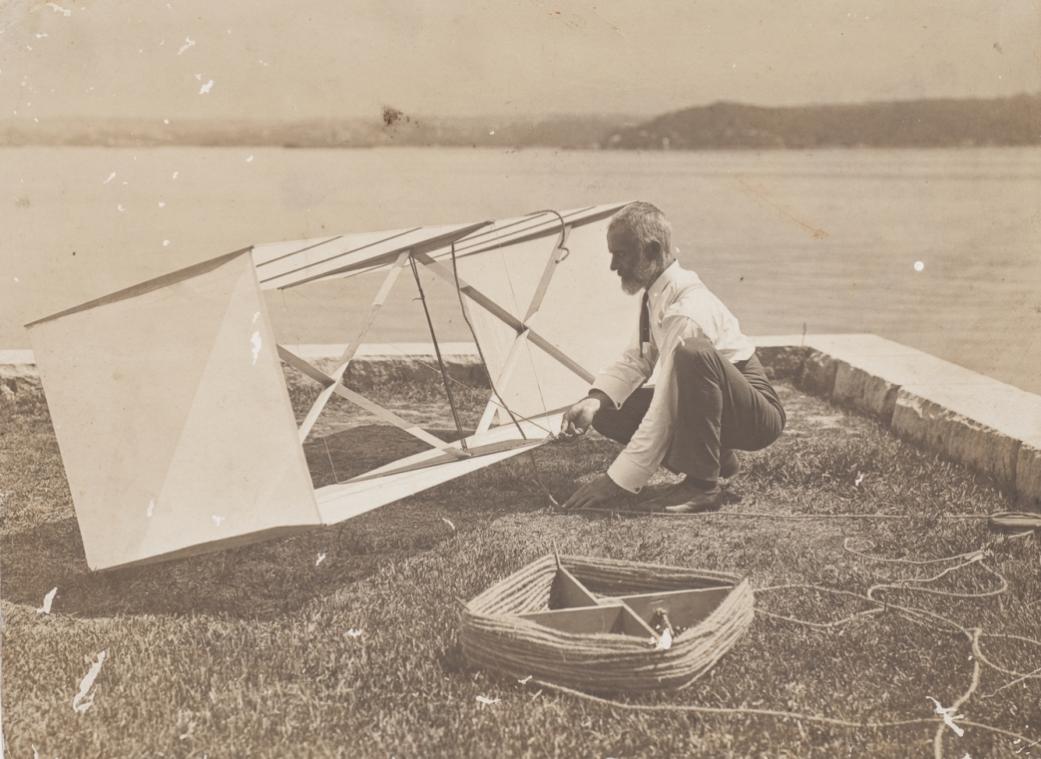
Lawrence Hargrave [working on a boxkite, Woollahra Point, ca. 1910] / photographer unknown
"Extract from Miss Gray's [the donor's] letter dated 8th Feb 1979. / My own view is that it [the photograph] was taken on the lawn at the back of his house at Wollahra [sic] Point, and Bradley Head is in the background. I appreciate that I may be mistaken. I think some of the Stanwell Park pictures show him as a dark-haired man." --Digital order no:a4217010- courtesy State Library of NSW